A sculpted skyline: Heatherwick Studio's Vessel puts Hudson Yards New York on the map

New York’s post-industrial renaissance continues, driven by land re-use, rising demand for residential, office and commercial property and a warm embrace of multi-level, multi-functional public spaces. Hudson Yards is the city's largest real estate development since the 22-acre Rockefeller Center was built in the 1930s. Located between 10th and 11th Avenues, the site is bisected by the curve of the High Line and ringed by a clutch of new buildings, including Diller Scofidio + Renfro's and Rockwell Group's 'The Shed' culture centre and tapering north and south towers, detailed to glossy perfection by high-rise experts Kohn Pedersen Fox. The tallest of these is around 1,200 ft high, offering up stark and lofty surroundings for a new public space in the heart of the 'Yards'.
Jay Cross is the man overseeing the site’s transition into a new chunk of city. The final brick won’t be laid until 2024, by which time Hudson Yards will accommodate offices, homes, shops, a school and hotel and 14 acres of gardens, walkways and squares. ‘Our objective is to create a great public space, a new crossroads for the city,’ says Cross, ‘and we wanted a central piece that would anchor all these buildings.’ That honour has gone to Heatherwick Studio, and the renders shown here mark the public debut of New York’s most extraordinary piece of infrastructure, dubbed 'Vessel' – part building, part sculpture, all accessible and designed to put Hudson Yards on the map.
Vessel is an extraordinary proposal. 'Our work couldn't be about height in a city where everything is about height, so we became interested in the human dimension – the most successful public spaces have the chemistry of interaction,' says Heatherwick. Drawing on his longstanding fascination with stairs and Indian stepwells, and New Yorkers' relentless emphasis on fitness and movement, Heatherwick and his team shaped a structure that could loosely be described as a 'climbing frame for adults'. Formed from a mesh of 154 individual flights of stairs, 80 landings and endless ribbons of balustrading and balconies, Vessel represents one mile of stairs and walkways winding up and up in a 16-storey steel puzzle, an MC Escher-esque construction that's willfully ambiguous but intended to be totally engaging.
‘Thomas is so ambidextrous as a designer – it’s hard to find someone who could move so easily between these specialities,’ says Cross. ‘The first vignette that he showed us was pretty dazzling and really, from the perspective of the design intent, what we are building is exactly the same.’ Every element of Vessel has been designed to serve the public space it sits in, from the narrow 50 ft base that flares out to 150 ft on the upper level, preserving as much park space as possible, to the reflective stainless steel panels (coated in a special copper finish) that are angled downwards to create dynamic views from the ground.
Vessel sits among five acres of urban park designed by Nelson Byrd Woltz Landscape Architects, with input from Heatherwick's team. The new outdoor space is intended as a seamless continuation of the planting and ethos of the nearby High Line, as well as connecting with the new Hudson Park & Boulevard green space. Planting has been inspired by New York's distant past as a verdant woodland, with an integral 200 ft water feature and 28,000 plant species in total. Thomas Woltz, Nelson Byrd Woltz's principal, describes the scheme as 'both technologically complex and beautifully natural', a public space 'inspired in part by the grand piazzas of Europe, including Rome’s Piazza del Campidoglio'.
One of the iconic images of New York is Lunch atop a Skyscraper, a vertiginous portrait of steel, modernity and human adventurousness, taken during the building of the Rockefeller Center. In some respects, the Vessel brings the pioneering spirit of the early skyscraper city to life, its 2,500 steps offering ample challenge to those willing to seek out a high-rise view, the mix of raw and treated metal evoking the hidden cores that hold up the modern city.
When Vessel is finally assembled and opened sometime in 2018, it’ll be up to New Yorkers to decide how it’s used (and named, as Heatherwick acknowledges). ‘As far as we’re concerned we want a great public space that people appreciate and adore,’ Cross says, but he admits it’s hard to predict how many visitors will come and what they’ll do. ‘We’re not sure how far people will walk up,’ he says, adding that only when they saw the piece under construction in Italy did they realise how theatrical the space would be. ‘It’s like a theatre in the round – there are a lot of ways to participate and there will be organised and unorganised activities.’

The Wallpaper* Game-Changer and 20th anniversary edition cover designer's response to the brief comprises a mesh of 154 individual flights of stairs, 80 landings and endless ribbons of balustrading and balconies
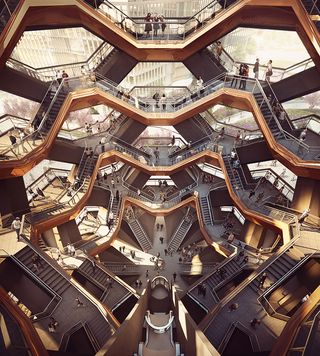
Vessel features one mile of stairs and walkways winding up and up in a 16-storey steel puzzle – an MC Escher-esque construction that's willfully ambiguous but intended to be totally engaging
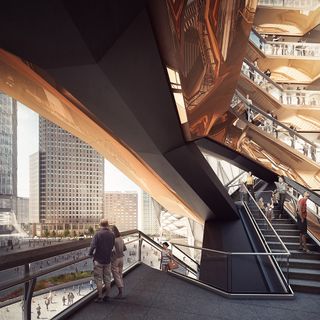
Every element of Vessel has been designed to serve the public space it sits in, from the narrow 50 ft base that flares out to 150 ft on the upper level, to the reflective stainless steel panels (coated in a special copper finish) that are angled downwards to create dynamic views from the ground
INFORMATION
For more information, visit the Hudson Yards New York website
Imagery: Forbes Massie
Wallpaper* Newsletter
Receive our daily digest of inspiration, escapism and design stories from around the world direct to your inbox
Jonathan Bell has written for Wallpaper* magazine since 1999, covering everything from architecture and transport design to books, tech and graphic design. He is now the magazine’s Transport and Technology Editor. Jonathan has written and edited 15 books, including Concept Car Design, 21st Century House, and The New Modern House. He is also the host of Wallpaper’s first podcast.
-
 A new limited-edition Rhodes piano and Gibson doubleneck guitar aim for the stars
A new limited-edition Rhodes piano and Gibson doubleneck guitar aim for the starsThe new Rhodes Mk8 Earth Edition piano and Gibson Jimmy Page EDS-1275 Doubleneck guitar revisit classic instruments at a price
By Jonathan Bell Published
-
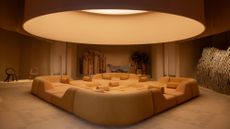 The new interior design trends we spotted at Salone del Mobile 2024
The new interior design trends we spotted at Salone del Mobile 2024These are the interior design trends to look out for in 2024 and beyond, from soft upholstery to conversation pits and low dining
By Rosa Bertoli Published
-
 Tiffany & Co nods to its theatrical history with a surreal new campaign
Tiffany & Co nods to its theatrical history with a surreal new campaignTiffany & Co campaign ‘With Love, Since 1837’ sees Dan Tobin Smith and set designer Rachel Thomas create an offbeat set
By Hannah Silver Published
-
 Shigeru Ban’s mini Paper Log House welcomed at The Glass House
Shigeru Ban’s mini Paper Log House welcomed at The Glass House'Shigeru Ban: The Paper Log House' is shown at The Glass House in New Canaan, USA as the house museum of American architect Philip Johnson plays host to the Japanese architect’s model temporary home concept
By Adrian Madlener Published
-
 Ray Phoenix to rise in Arizona
Ray Phoenix to rise in ArizonaRay Phoenix housing project launches, designed by Johnston Marklee, who worked with Lamar Johnson Collaborative, for property experts Ray and Vela
By Ellie Stathaki Published
-
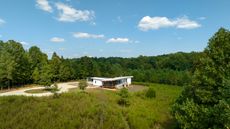 A low-energy farmhouse provides a rural escape in North Carolina
A low-energy farmhouse provides a rural escape in North CarolinaThis low-energy farmhouse is a net zero architectural re-set for a Californian client, an East Coast relocation for a more engaged and low-key lifestyle
By Jonathan Bell Published
-
 A Petra Island house rises from Frank Lloyd Wright's original drawings
A Petra Island house rises from Frank Lloyd Wright's original drawingsBased on Frank Lloyd Wright drawings, the cantilevering Petra Island Massaro House, located in New York’s Hudson Valley, is now open to visitors
By Craig Kellogg Published
-
 Modernist architecture: inspiration from across the globe
Modernist architecture: inspiration from across the globeModernist architecture has had a tremendous influence on today’s built environment, making these midcentury marvels some of the most closely studied 20th-century buildings; check back soon for new additions to our list
By Ellie Stathaki Published
-
 An Upper West Side apartment by General Assembly nods to its history
An Upper West Side apartment by General Assembly nods to its historyAn Upper West Side apartment in New York, born out of the reimagining of two neighbouring units, is refreshed by General Assembly for a young family
By Ellie Stathaki Published
-
 New York's Leica store echoes the brand's blend of heritage and innovation
New York's Leica store echoes the brand's blend of heritage and innovationLeica store throws open its doors in New York's Meatpacking District, courtesy of Brooklyn based Format Architecture Office
By Adrian Madlener Published
-
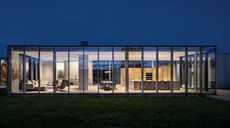 Hudson Valley Residence is a low-lying retreat that seamlessly blends into the horizon
Hudson Valley Residence is a low-lying retreat that seamlessly blends into the horizonDesigned by HGX Design, Hudson Valley Residence is a scenic home offering unobstructed views across the Catskill Mountains in Upstate New York
By Tianna Williams Published